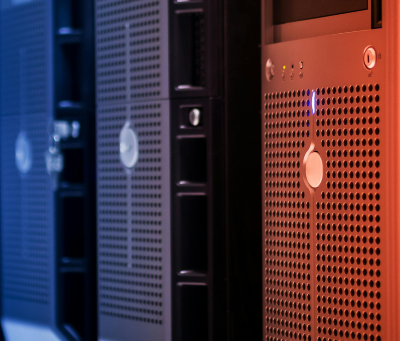The Critical Role of IT Modernization

Why IT Modernization Is More Than Just an Upgrade
- Businesses today face rapid technological evolution, growing security threats, and increasing demands for efficiency and scalability.
- IT modernization is not simply about upgrading systems—it is about restructuring technology environments to drive agility, security, and long-term resilience.
- Organizations that fail to modernize risk operational inefficiencies, escalating costs, security vulnerabilities, and competitive disadvantages in an increasingly digital world.
The IT Modernization Challenge
- Many enterprises operate with outdated infrastructure, fragmented cloud adoption, and legacy applications, making it difficult to scale, innovate, and secure their operations.
- Hybrid and multi-cloud environments, automation, and AI-driven processes are redefining IT landscapes, but organizations often struggle with integration, governance, and cost management.
- Without a clear modernization roadmap, IT transformation efforts can result in unexpected disruptions, budget overruns, and security risks instead of delivering business value.
Why This Matters Now: The Urgency of IT Modernization
- Evolving Security & Risk Management Needs – Businesses across all industries face rising cybersecurity threats, ransomware attacks, and data breaches, necessitating modern, zero-trust security architectures and proactive threat management.
- Cloud & Digital Acceleration – As enterprises embrace cloud, automation, and remote work, they must adopt flexible, scalable IT solutions that support growth and innovation.
- The Cost of Legacy Systems – Outdated IT environments increase maintenance costs, hinder performance, and create security loopholes, making modernization essential for operational efficiency.
- Competitive & Market Pressures – In today’s digital economy, businesses that modernize IT gain a strategic advantage—leveraging AI, cloud-native solutions, and DevOps to drive faster innovation and improved customer experiences.
IT Modernization: A Business Imperative
IT modernization is not just about technology—it’s a business imperative that fuels agility, security, and long-term success.
The Pillars of IT Modernization Services
Strategic Value of IT Modernization (Why IT Modernization is the Foundation of Business Resilience & Growth)
The Financial and Operational Risks of Legacy IT Systems
- How outdated infrastructure increases operational costs and reduces efficiency.
- The hidden risks of maintaining legacy applications—security vulnerabilities, lack of support, and inability to integrate with modern cloud environments.
- Business disruptions caused by fragmented IT environments—inconsistent security policies, decentralized access management, and inefficiencies in multi-cloud operations.
How IT Modernization Enhances Agility & Scalability Across Industries
- Unifying cloud and on-premise systems to create a flexible, high-performance IT environment.
- Eliminating operational silos by optimizing identity management and infrastructure security.
- Enhancing workforce productivity by reducing IT bottlenecks and enabling seamless collaboration through modernized applications and cloud-first strategies.
Aligning IT with Long-Term Business Goals
- Modern IT architecture as the foundation for AI adoption, automation, and data-driven decision- making.
- How IT modernization supports business continuity, cybersecurity resilience, and future expansion plans.
- Preparing IT environments for mergers, acquisitions, and digital transformation initiatives.






Infrastructure Modernization: Building the Foundation for Secure, Scalable IT
The Risks of Outdated Infrastructure in a Digital-First World
- Performance bottlenecks and security vulnerabilities caused by aging IT environments.
- The rising costs of maintaining legacy infrastructure compared to cloud-enabled, automated solutions.
- Increased cybersecurity risks due to outdated hardware, network architectures, and identity management systems.
How Modern Infrastructure Drives Business Efficiency
- Optimizing IT architecture to support remote work, cloud adoption, and AI-driven applications.
- Enabling hybrid cloud solutions for seamless workload distribution and enhanced security.
- Strengthening IT governance and compliance by integrating Zero Trust security models and automated access controls.
Future-Proofing IT with Scalable, Adaptive Infrastructure
- Why businesses must shift to software-defined networking and cloud-based architectures.
- How automation and AI-driven monitoring reduce downtime and optimize IT performance.
- Preparing IT environments for continuous innovation, expansion, and security compliance.
Cloud Transformation: Unlocking Agility & Innovation with a Cloud-First Approach
The Business Risks of Delayed Cloud Adoption
- Why traditional IT environments struggle to keep pace with digital transformation.
- The cost inefficiencies of on-prem data centers compared to scalable cloud solutions.
- Security concerns and compliance challenges associated with fragmented cloud implementations.
Optimizing Cloud Adoption for Maximum Business Value
- Migrating to cloud-native architectures for enhanced flexibility and cost efficiency.
- Integrating DevOps and automation to streamline cloud operations.
- Leveraging hybrid and multi-cloud strategies to maximize scalability and resilience.
The Role of Cloud-Native Identity & Access Management (ICAM)
- Ensuring seamless authentication and authorization across cloud and hybrid environments.
- Reducing security risks with Zero Trust frameworks and adaptive identity controls.
- Unifying cloud identity management for enhanced security, compliance, and user experience.






Application Modernization: Transforming Legacy Systems for the Digital Era
The Cost & Risk of Running Legacy Applications
- How outdated applications drain IT budgets and slow business innovation.
- Security vulnerabilities in legacy systems that expose businesses to cyber threats.
- Challenges of integrating legacy applications with modern cloud ecosystems.
Streamlining & Future-Proofing Applications
- Application rationalization to reduce redundancy and improve efficiency.
- Migrating legacy applications to cloud-native platforms for scalability and security.
- Automating workflows and integrating AI-driven analytics for smarter business operations.
The Role of Application Modernization in Business Growth
- Enabling seamless digital transformation by modernizing core business applications.
- Aligning IT strategy with evolving customer expectations and operational needs.
- Enhancing security, performance, and user experience through modernization initiatives.
The Integration Roadmap: A Step-by-Step Approach
1
Assessment & Strategic Planning
Before embarking on IT modernization, organizations must understand their current IT landscape, define strategic objectives, and identify areas for improvement. This phase lays the foundation for a targeted, cost-effective modernization strategy that aligns with business needs.
Key Activities in This Phase:- Infrastructure & Application Audit: Conduct a comprehensive assessment of hardware,software, security policies, and operational inefficiencies.
- Gap Analysis & Pain Points Identification: Determine areas of risk, outdated technology, and operational bottlenecks that hinder growth.
- Alignment with Business Goals: Define how IT transformation supports revenue growth, operational efficiency, and innovation.
- Regulatory & Compliance Review: Evaluate security frameworks and compliance mandates (such as NIST, GDPR, and industry-specific regulations).
- Risk Assessment & Cost Analysis: Identify potential modernization risks and estimate the investment required for long-term value.
Outcome: A strategic roadmap that provides clear priorities, modernization goals, and a phased approach for execution.
2
Designing the Future State Architecture
With a clear understanding of IT priorities, organizations must design a future-ready IT environment that supports hybrid infrastructure, cloud adoption, security best practices, and business scalability.
Key Components of Future State Design:- Cloud & Hybrid Infrastructure Blueprint: Establishing the right mix of on-prem, private, and public cloud solutions.
- Security & Identity Management Framework: Implementing Zero Trust security models, ICAM (Identity, Credential, and Access Management), and role-based access controls.
- Application Modernization Strategy: Defining which legacy applications should be retired, re- platformed, or rebuilt to align with cloud-native environments.
- Governance & Policy Development: Creating IT governance models that standardize operations, compliance, and security practices.
- Automation & DevOps Readiness: Ensuring systems support continuous integration, deployment automation, and real-time monitoring.
Outcome:A strategic roadmap that provides clear priorities, modernization goals, and a phased approach for execution.
3
Implementation & Seamless Transition
Executing IT modernization requires a phased approach to minimize disruptions and ensure a smooth transition for employees, customers, and operational processes. Hekima follows structured implementation methodologies that accelerate transformation while safeguarding business continuity.
Key Considerations for Execution:- Infrastructure Modernization Rollout: Upgrading hardware, networking, and cloud environments without interrupting critical business functions.
- Application Migration & Cloud Adoption: Moving workloads to optimized cloud platforms while ensuring application performance and security.
- Identity & Access Management (IAM) Deployment: Securing user access and implementing single sign-on (SSO), multi-factor authentication (MFA), and cloud-native identity solutions.
- Security Hardening & Compliance Validation: Strengthening IT environments with real-time threat detection, network segmentation, and automated security policies.
- Employee & IT Staff Training: Ensuring organizational readiness through training programs that enable teams to leverage new technologies effectively.
- Phased Deployment & Pilot Testing: Executing controlled rollouts, testing, and feedback loops before full-scale implementation.
Outcome:A successfully modernized IT environment that enhances agility, security, and efficiency—all while minimizing operational risks.
4
Optimization & Continuous Improvement
IT modernization is not a one-time initiative—it requires continuous monitoring, performance tuning, and security enhancements to keep pace with evolving threats and business demands.
Key Aspects of Long-Term IT Optimization:- Cloud & Infrastructure Performance Tuning: Ongoing monitoring of resource utilization, cloud cost optimization, and performance benchmarking.
- Automation & AI-Powered Efficiency: Leveraging AI-driven analytics, automation, and predictive monitoring to detect issues before they impact operations.
- Proactive Security & Threat Mitigation: Implementing real-time security monitoring, continuous penetration testing, and Zero Trust compliance updates.
- Agile & DevOps-Enabled IT Strategy: Establishing an iterative improvement process with continuous deployment pipelines and rapid response mechanisms
- Data-Driven Decision Making: Using business intelligence (BI) and analytics to measure the ROI of modernization efforts and drive further optimization.
Outcome:A self-improving IT ecosystem that remains agile, secure, and scalable—ready to support business innovation, digital transformation, and future growth.




Future-Proofing Enterprise Identity Security
Why IT Modernization Is the Key to Long-Term Success
- Enhanced Security & Risk Mitigation – Modern IT environments incorporate Zero Trust security models, automated threat detection, and compliance-driven access controls to reduce vulnerabilities and safeguard critical assets.
- Cost Optimization & Operational Efficiency – Moving away from expensive legacy systems and adopting scalable cloud solutions allows businesses to optimize IT spending while improving performance.
- Future-Ready Infrastructure – IT modernization paves the way for AI-driven decision-making, automation, and digital transformation, ensuring organizations remain agile and competitive.
- Seamless Integration & Business Continuity – A modernized IT framework ensures secure, uninterrupted operations, allowing businesses to scale, adapt, and grow without technological roadblocks.


